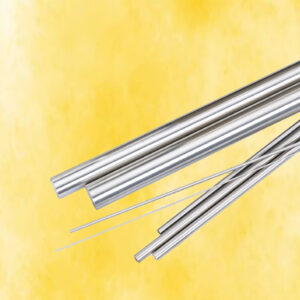
In the world of stainless steel, the 300 series reigns supreme. Known for their impressive corrosion resistance, unique chemical composition, and remarkable resilience in extreme temperatures, these alloys are a top choice for numerous industries. But what is it that makes this series so versatile and reliable? Let’s delve deeper into the fundamental advantages of 300 series stainless steel and shed light on two of its eminent grades: 304 and 316.
Understanding the 300 Series Stainless Steel
The 300 series falls under the broader category of austenitic stainless steels – non-magnetic, not heat-treatable metals that can develop high strength through cold working. Their composition primarily includes chromium (17-25%) and nickel (8-25%). Some variants within this series also contain molybdenum up to 7%, enhancing their corrosion resistance, especially against pitting and crevice corrosion.
But what sets this series apart is its exceptional formability, resistance to wear, and strength at temperature. These factors make the 300 series an ideal choice for a variety of applications in industries such as food & beverage, oil & gas, cryogenic, and marine applications.
Diving Into Chemical Composition
When we talk about “what is stainless steel,” we’re essentially talking about a blend of multiple elements that give rise to its distinctive characteristics. The key elements that constitute the 300 series alloys include chromium, nickel, molybdenum, carbon, manganese, phosphorous, sulfur, silicon, titanium, and nitrogen.
To understand better let’s look at two prominent members of the 300 series family: 304-grade and 316-grade stainless steel.
What is 304 Grade Stainless Steel?
The 304-grade stainless steel, also known as 18/8 stainless due to its composition of 18% chromium and 8% nickel, is the most common type of stainless steel used around the world. It’s incredibly versatile and offers excellent formability and weldability, making it suitable for a wide range of applications.
Here’s a snapshot of its chemical composition:
- Chromium: 18% – 20%
- Nickel: 8% – 10.5%
- Carbon: 0.08%
- Manganese: 2%
- Phosphorous: 0.045%
- Sulfur: 0.03%
- Silicon: 0.75%
- Nitrogen: 0.1%
What is Stainless Steel 316 Grade?
Then we have the stainless steel grade 316, often referred to as the “marine grade.” Thanks to the addition of molybdenum (2%-3%), this variant demonstrates superior corrosion resistance, especially against chlorides like seawater.
Here’s what goes into the making of the stainless steel grade 316:
- Chromium: 16% – 18%
- Nickel: 10% – 14%
- Molybdenum: 2% – 3%
- Carbon: 0.08%
- Manganese:2%
- Phosphorous:0.045%
- Sulfur:0.03%
- Silicon:0.75%
- Nitrogen:0.1%
Corrosion Resistance and Pitting
A defining trait of the entire stainless steel family is corrosion resistance, and the alloys in the 300 series are no exception.
While all grades offer decent protection against corrosion, certain variants like the aforementioned stainless steel grade 316 exhibit heightened resistance due to their modified chemical structures. The addition of molybdenum, for instance, enhances resistance to pitting corrosion, a form of localized corrosion that leads to small cavities or “pits” in the metal.
To gauge the resistance of different alloys to pitting corrosion, we use the Pitting Resistance Equivalent Number (PREN). For example, 316 and 304-grade stainless steel have PRENs ranging from 18.0 – 20.0 and 22.6 – 27.9 respectively, indicating that grade 316 has superior resistance to pitting.
Withstanding Extreme Temperatures
Another hallmark of the 300 series stainless steel is its impressive resilience under extreme temperatures. These alloys can withstand a wide range of temperatures while maintaining their integrity.
Many stainless steel alloys, including those in the 300 series, maintain their strength and corrosion resistance at high temperatures. This makes stainless steel tubing a suitable choice for applications such as heat exchangers, exhaust systems, and industrial furnaces where exposure to high temperatures is required.
Stainless steel retains its strength and ductility even in sub-zero temperatures, making it an excellent choice for applications in cold environments. It is often used in various industries such as cryogenic applications, refrigeration systems, cold storage facilities, and other cold temperature applications.
A Versatile Choice for Various Applications
Thanks to their unique blend of properties – including excellent formability, superior corrosion resistance, and impressive resilience under extreme conditions – the alloys in the 300 series are suitable for an array of applications across various industries.
Whether it’s for food & beverage processing equipment due to their non-reactive nature or for oil & gas operations due to their high-temperature resilience – these stainless steels can handle it all.
For instance, they are ideal for creating stainless steel tubing used in high-pressure environments or marine applications where resistance against seawater corrosion is critical. However, it’s crucial to match the alloy type with specific requirements and environmental conditions to ensure optimal performance and durability.
Unraveling the Strength of 300 Series Stainless Steel
The 300 series stainless steel is a versatile and reliable choice in numerous applications due to its impressive corrosion resistance, unique chemical composition, and resilience under extreme temperatures. Whether you’re exploring the world of stainless steel for the first time or looking to deepen your understanding, knowing the fundamentals of this remarkable series will certainly guide you in making more informed decisions suitable for your specific needs.
Contact the Experts at Eagle Stainless
Eagle Stainless is a trusted stainless steel tubing and bar manufacturer, utilizing the latest technology to create unparalleled, state-of-the-art solutions for our customers. To learn more about our stainless steel tubing products, please contact us at Eagle Stainless today.



